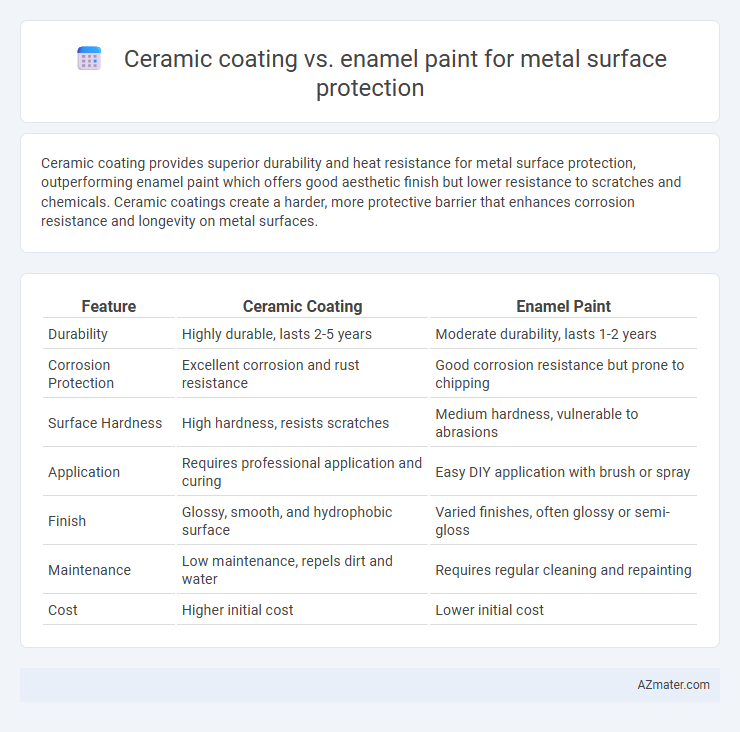Ceramic coating provides superior durability and heat resistance for metal surface protection, outperforming enamel paint which offers good aesthetic finish but lower resistance to scratches and chemicals. Ceramic coatings create a harder, more protective barrier that enhances corrosion resistance and longevity on metal surfaces.
Table of Comparison
| Feature | Ceramic Coating | Enamel Paint |
|---|---|---|
| Durability | Highly durable, lasts 2-5 years | Moderate durability, lasts 1-2 years |
| Corrosion Protection | Excellent corrosion and rust resistance | Good corrosion resistance but prone to chipping |
| Surface Hardness | High hardness, resists scratches | Medium hardness, vulnerable to abrasions |
| Application | Requires professional application and curing | Easy DIY application with brush or spray |
| Finish | Glossy, smooth, and hydrophobic surface | Varied finishes, often glossy or semi-gloss |
| Maintenance | Low maintenance, repels dirt and water | Requires regular cleaning and repainting |
| Cost | Higher initial cost | Lower initial cost |
Introduction: Metal Surface Protection Essentials
Ceramic coating offers a high-gloss, durable layer that resists chemicals, UV rays, and scratches, extending metal surface lifespan significantly. Enamel paint provides a cost-effective and versatile protective barrier with moderate resistance to corrosion and weathering but may require frequent touch-ups. Selecting between ceramic coating and enamel paint depends on factors like exposure conditions, budget, and desired durability for metal surface protection.
Understanding Ceramic Coating: Properties and Applications
Ceramic coating offers superior hardness and chemical resistance compared to enamel paint, making it ideal for metal surface protection in harsh environments. Its nano-ceramic particles create a hydrophobic, durable layer that resists corrosion, UV damage, and abrasion. Common applications include automotive exteriors, industrial machinery, and aerospace components where long-lasting protection and enhanced surface longevity are critical.
What is Enamel Paint? Composition and Use Cases
Enamel paint is a durable coating composed of synthetic resins, solvents, and pigments designed for metal surface protection, offering resistance to moisture, chemicals, and abrasion. It is commonly used in industrial applications, automotive parts, and household appliances due to its glossy finish and long-lasting performance. The formulation provides a hard, protective layer that enhances corrosion resistance and aesthetic appeal on metal surfaces.
Durability Comparison: Ceramic Coating vs Enamel Paint
Ceramic coating offers superior durability for metal surface protection compared to enamel paint due to its enhanced resistance to UV rays, chemical exposure, and abrasion. While enamel paint forms a protective layer that can chip and fade over time, ceramic coating creates a harder, more resilient bond that extends the lifespan of the metal surface. The longevity and maintenance benefits of ceramic coating make it a more cost-effective solution for long-term metal protection.
Resistance to Corrosion and Environmental Factors
Ceramic coating offers superior resistance to corrosion and environmental factors compared to enamel paint due to its chemically inert and non-porous surface, which creates a durable barrier against moisture, UV radiation, and chemical exposure. Enamel paint provides moderate protection but tends to degrade over time when exposed to harsh weather conditions, leading to potential rust and surface deterioration. For long-term metal surface protection, ceramic coatings are preferred for their enhanced corrosion resistance and ability to withstand extreme environmental stressors.
Application Process: Ease and Requirements
Ceramic coating offers a straightforward application process requiring minimal surface preparation, typically involving thorough cleaning and decontamination to ensure proper adhesion. Enamel paint demands more intensive preparation, including sanding, priming, and multiple paint layers for optimal durability and finish. Ceramic coatings cure quickly and provide a smooth, hard finish with fewer application steps, whereas enamel paint involves longer drying times and additional coats to achieve comparable protection on metal surfaces.
Maintenance and Longevity: What to Expect
Ceramic coating on metal surfaces offers superior durability and resistance to scratches, chemicals, and UV rays, significantly reducing maintenance frequency compared to enamel paint. Enamel paint may require regular touch-ups and recoating due to its susceptibility to chipping and fading over time. Ceramic coatings can maintain their protective properties for up to 5-10 years, whereas enamel paint typically lasts 2-5 years under similar conditions.
Cost Analysis: Initial Investment and Long-Term Value
Ceramic coating offers a higher initial investment compared to enamel paint, typically ranging from $500 to $1,500 depending on the application area and product quality, whereas enamel paint costs around $50 to $150 per gallon. Despite the higher upfront cost, ceramic coatings provide superior durability, chemical resistance, and longevity, often lasting 5 to 10 years without reapplication, compared to enamel paint which may require annual or biennial touch-ups. This long-term value of ceramic coatings reduces maintenance expenses and prolongs metal surface protection, making it a more cost-effective option over time despite the significant initial investment.
Aesthetic Differences: Finish and Color Options
Ceramic coating offers a glossy, glass-like finish that enhances the metal surface's depth and often includes hydrophobic properties for easier cleaning. Enamel paint provides a wide range of matte, satin, and glossy color options, allowing for greater customization but may lack the reflective quality and durability of ceramic coatings. While ceramic coatings emphasize long-lasting shine and subtle color enhancement, enamel paints prioritize vibrant color variety and texture versatility for metal surface protection.
Choosing the Right Solution for Your Metal Surface
Ceramic coating offers superior durability and resistance to scratches, heat, and chemicals, making it ideal for high-performance metal surfaces exposed to harsh environments. Enamel paint provides a cost-effective, glossy finish that protects against rust and corrosion for everyday metal applications with moderate exposure. The choice depends on the metal's exposure conditions and budget, with ceramic coatings favored for long-term protection and enamel paint suitable for aesthetic appeal and basic rust prevention.

Infographic: Ceramic coating vs Enamel paint for Metal surface protection
 azmater.com
azmater.com